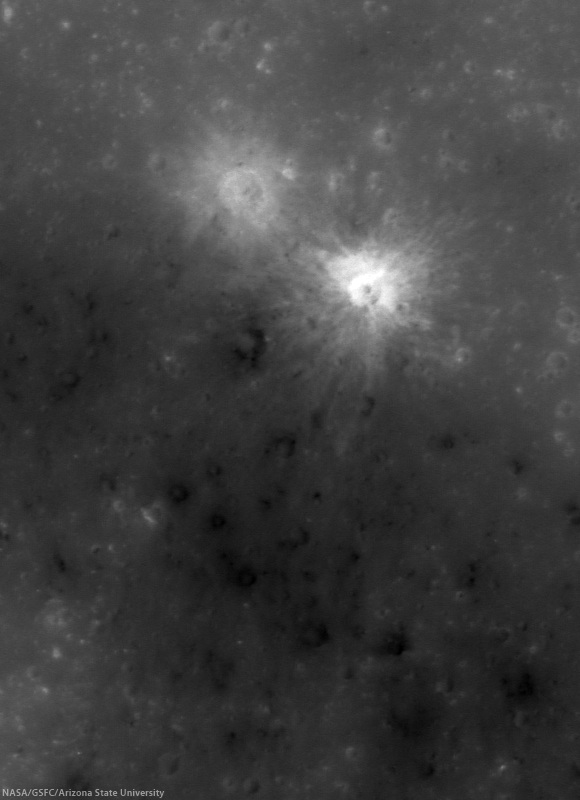 |
| Thin Skin? A patch of Dark Mantle Deposits, prominent albedo features of west and east Sinus Aestuum (southeast of Copernicus) have been over-turned by relatively recent impact, uncovering much brighter material not far below the surface. From LROC Narrow Angle Camera (NAC) observation M1103666930R, orbit 14961, September 30, 2012; resolution 94 cm per pixel. LROC Featured Image center 4.591°N, 344.348°E, field of view above is 545 meters across [NASA/GSFC/Arizona State University]. |
Hiroyuki Sato
LROC News System
Dark Mantle Deposits (DMDs) are diffuse deposits with a very low albedo, which are the remnants of pyroclastic eruptions. Sinus Aestuum is a DMD near Copernicus crater.
Today's Featured Image (covers) a portion of one of the lowest-reflectance areas in this DMD (see next WAC context images below), about 150 km southeast from Copernicus.
In the opening image, the lowest-reflectance materials are located at the rims and the ejecta of the multiple small craters (less than 20 meters in diameter), indicating that these dark materials are in the shallow subsurface.
the most accessible lunar resources that could be used by future human explorers to enable extended lunar surface operations.
HERE.
Related Posts:
Pyroclastic Trails
Pyroclastics and Vent
Hyginus Crater and Pyroclastics
Pyroclastic Excavation
Rima Bode: Constellation Region of Interest
LROC News System
Dark Mantle Deposits (DMDs) are diffuse deposits with a very low albedo, which are the remnants of pyroclastic eruptions. Sinus Aestuum is a DMD near Copernicus crater.
Today's Featured Image (covers) a portion of one of the lowest-reflectance areas in this DMD (see next WAC context images below), about 150 km southeast from Copernicus.
In the opening image, the lowest-reflectance materials are located at the rims and the ejecta of the multiple small craters (less than 20 meters in diameter), indicating that these dark materials are in the shallow subsurface.
the most accessible lunar resources that could be used by future human explorers to enable extended lunar surface operations.
HERE.
Related Posts:
Pyroclastic Trails
Pyroclastics and Vent
Hyginus Crater and Pyroclastics
Pyroclastic Excavation
Rima Bode: Constellation Region of Interest






No comments:
Post a Comment